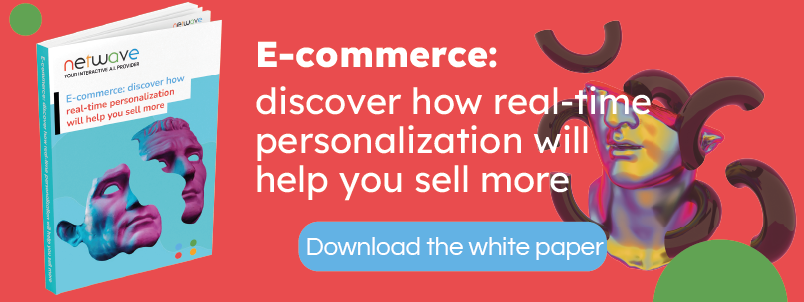
Customer focus is the key to success, whether a physical shop or an online platform. But how do you maximise customer satisfaction and experience in the digital e-commerce environment? How can we implement the best in-store customer care to the Internet user’s independent purchasing journey?
Inductive Artificial Intelligence offers the prospect personalised shopping suggestions in real time. Able to compensate for the lack of human intermediation, this technology reproduces the most efficient in-store salespeople practices perfectly and transparently for the Internet user.
1. Cross-selling and up-selling or how to increase the average basket size
These two additional sales techniques represent a significant growth lever for both physical shops and e-commerce sites. They play an essential role in profitability.
Cross-selling: offering complementary customer products
Cross-selling is a particularly effective additional sales technique in a shop, which increases the average basket and anticipates and answers customers' needs in real-time. A salesperson in a shoe shop will naturally suggest soles or shoe polish. A toy shop will display all kinds of batteries needed to operate various electronic games at the checkout.
E-commerce must rely on efficient recommendation algorithms to offer relevant complementary products without human intervention.
2. Understand Internet users' expectations by analysing weak and strong signals
In the shop, a sales assistant must pay attention to strong signals, when the customer expresses their expectations, such as: "Hello, I'm looking for an indestructible smartphone". But he must also be attentive to the weak or implicit signals sent by the customer, such as his age group, clothing, or doubts.
In the same way, an Internet user’s journey on your site is relevant to determine his buyer profile and identifying his needs. Do they go for new products or promotions? Do they know exactly what they are looking for? Do they choose according to price? Are they sensitive to other people’s opinions? At what time of day do they do their research?
E-commerce platforms must be able to follow this navigation journey in real time and gather as many weak signals as possible to offer a personalised and optimised customer experience.
3. Reducing choice to reassure the customer
Paradoxically, too many choices can paralyse a customer’s purchasing process, generating anxiety, uncertainty and even frustration. How, for example, can you walk into a Darty store and not be overwhelmed by the wall of television sets? If we had to analyse the technical characteristics of all these sets to identify the one that suits us best, we would no doubt be discouraged! Fortunately, the salesperson is there to guide us, analyse our needs and drastically reduce the choice we have to make. Reducing this uncertainty can significantly increase conversion rates.
The Internet user faces the same problem, made worse by the absence of exposed costs, and the marketplace practice generates spectacular inflation of the offer. And he cannot rely on human intermediation. Therefore, it's crucial that e-commerce sites simplify the visitor’s choice, by reducing information according to the intention of purchase to maximise conversion.
4.Refining advice in real time
Proactive, a salesperson adapts in real-time to customer requests. Is this television too big, too expensive? They will carefully avoid providing one of the same size or price unless they realise you are particularly hesitant.
In the same way, an e-commerce site must be able to refine its recommendations at each stage of the purchasing process and thus analyse the slightest change in expectations and needs in real-time. It is essential to observe the changes in the Internet user's behaviour in real-time to identify, for example, the transition between the initial novelty hunter into the bargain hunter once they see the site's offer.
In addition, the site must be able to adapt to consumer trends. Let's imagine that a scandal affects the cotton industry. The media coverage of the affair will have immediate repercussions on consumers' buying behaviour. For example, they could turn towards linen clothes. The shop assistant will naturally adapt to this situation. Personalised suggestions in e-commerce must be able to do the same. Immediately, without waiting for linen sales to overtake cotton sales in the learning base of the statistical machine.
To stick to the Internet user’s state of mind and consumer trends at any given moment, automated suggestions cannot be based on fixed statistical models, trying to force the customer into a predefined segment and relying on outdated sales histories as soon as they are formulated. Only inductive artificial intelligence can implement these personalised and proactive recommendations in real-time.
5. Induction or the power of human analysis at the service of Artificial Intelligence
The human brain mostly uses induction to make decisions: it generalises an experience or reasoning from observing a limited number of particular cases or even from a single experience. Each new context will test this simplification, identifying analogies between the current situation and previous ones and adapting the strategy to be followed in real-time.
This is the particularly effective cognitive function the salesperson uses, for example, when they rely on past sales experience to offer a product to a customer. His sales performance depends on his ability to modify his recommendations as soon as the customer deviates from the model that the inductive analysis enabled him to sketch.
In the same way, Artificial Intelligence, which serves the automated recommendations of e-commerce sites, must not be based on fixed statistical algorithms. Their deductive logic only identifies what was, on average, the most probable in the past without adapting in real-time to each Internet user's specific and changing profile. It is only relevant in the case of highly prevalent and perennial phenomena.
On the other hand, inductive AI can capture these game changers at a given moment and for a specific customer by analysing their navigation's contextual, behavioural, and psychological dimensions.
Thanks to its exclusive Inductive AI technology, Netwave's strength lies in its ability to place all these essential elements of real-time recommendation personalisation at the heart of e-commerce in a way that is transparent to the Internet user for a qualitative, attractive, and optimised customer experience.
Netwave allows you to re-interact the customer relationship on your e-commerce site by reproducing the physical seller’s expertise. You meet your visitors' needs and offer them a truly personalised experience. A project? Do you have a question? Contact us now!

